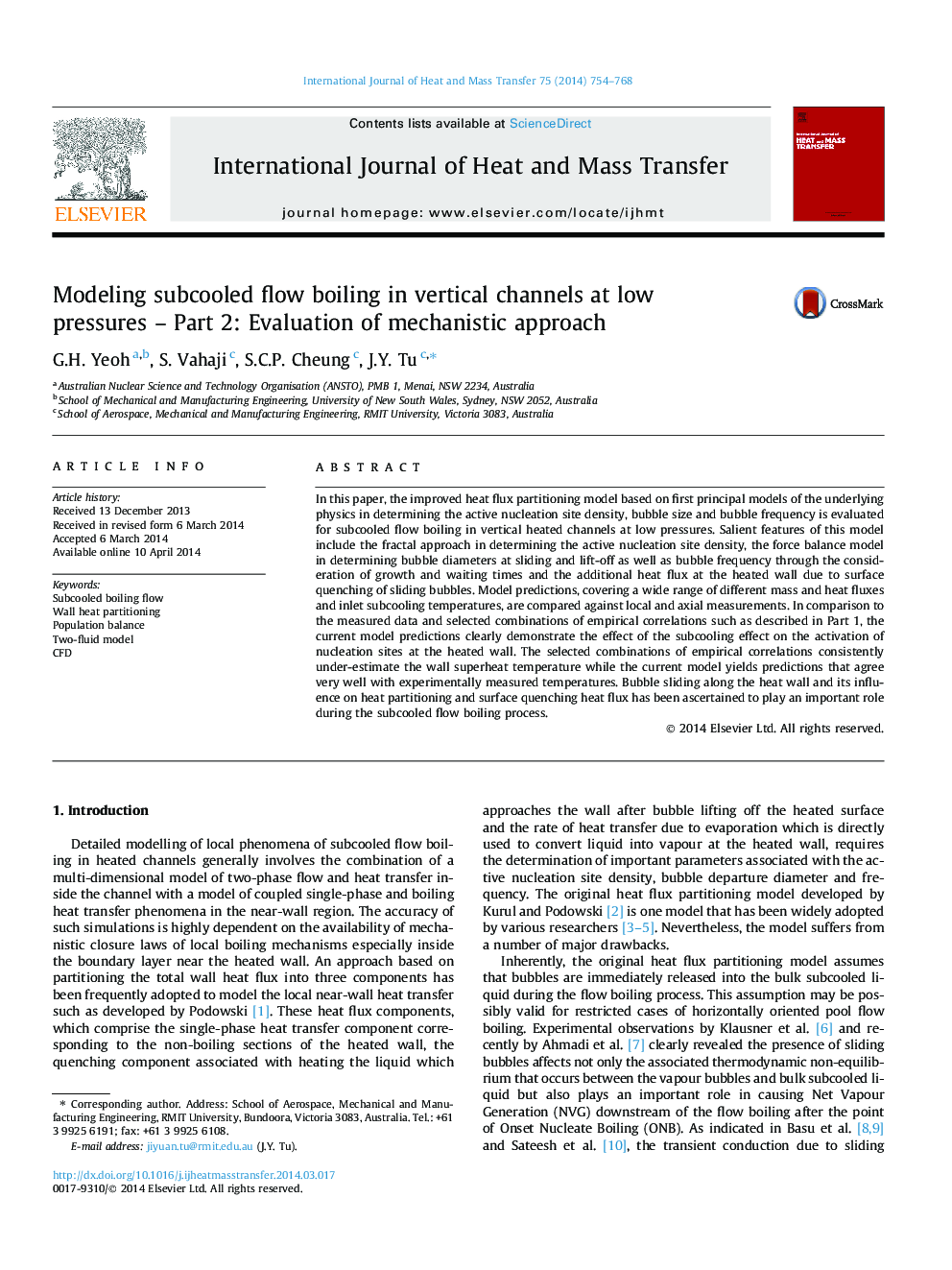| کد مقاله | کد نشریه | سال انتشار | مقاله انگلیسی | نسخه تمام متن |
|---|---|---|---|---|
| 7057165 | 1458067 | 2014 | 15 صفحه PDF | دانلود رایگان |
عنوان انگلیسی مقاله ISI
Modeling subcooled flow boiling in vertical channels at low pressures - Part 2: Evaluation of mechanistic approach
ترجمه فارسی عنوان
مدل سازی جریان جوش شیرین در کانال های عمودی در فشار کم - قسمت 2: ارزیابی رویکرد مکانیکی
دانلود مقاله + سفارش ترجمه
دانلود مقاله ISI انگلیسی
رایگان برای ایرانیان
کلمات کلیدی
ترجمه چکیده
در این مقاله، مدل پارتیشن بندی جریان شار حرارتی بهبود یافته بر اساس مدل های اصلی اولیه فیزیک پایه در تعیین چگالی محلول فعال، اندازه حباب و فرکانس حباب برای جوش خوردن جوش خورده در کانالهای عمودی گرم در فشار کم مورد بررسی قرار می گیرد. ویژگی های برجسته این مدل عبارتند از: روش فراکتال در تعیین چگالی سایت هسته فعال، مدل تعادل نیرو در تعیین قطر حباب در لغزش و بلند کردن و همچنین فرکانس حباب با توجه به رشد و زمان انتظار و شار حرارت اضافی در دیوار گرم به علت خشک شدن سطح حباب های کشویی. پیش بینی های مدل، پوشش طیف گسترده ای از جرم های مختلف و گرمای جریان و درجه حرارت زیر کولر ورودی، در مقایسه با اندازه گیری های محلی و محوری مقایسه شده است. در مقایسه با داده های اندازه گیری شده و ترکیبات انتخاب شده از همبستگی تجربی، مانند شرح داده شده در قسمت 1، پیش بینی های مدل فعلی به طور واضح اثرات اثر غلظت سرد شدن بر فعال سازی محل های هسته را در دیوار گرم شده نشان می دهد. ترکیب های انتخاب شده از همبستگی تجربی به طور مداوم به طور معنی داری دمای حرارت دیواره را تحت تأثیر قرار می دهند در حالیکه مدل جاری پیش بینی هایی را که با دماهای اندازه گیری آزمایشگاهی بسیار مناسب است، به دست می آورد. حباب کشویی در امتداد دیوار گرمایی و تأثیر آن در پراکندگی گرما و شار حرارتی خنک کننده سطح تعیین شده است که نقش مهمی در فرآیند جوشیدن جوش داده شده دارد.
موضوعات مرتبط
مهندسی و علوم پایه
مهندسی شیمی
جریان سیال و فرایندهای انتقال
چکیده انگلیسی
In this paper, the improved heat flux partitioning model based on first principal models of the underlying physics in determining the active nucleation site density, bubble size and bubble frequency is evaluated for subcooled flow boiling in vertical heated channels at low pressures. Salient features of this model include the fractal approach in determining the active nucleation site density, the force balance model in determining bubble diameters at sliding and lift-off as well as bubble frequency through the consideration of growth and waiting times and the additional heat flux at the heated wall due to surface quenching of sliding bubbles. Model predictions, covering a wide range of different mass and heat fluxes and inlet subcooling temperatures, are compared against local and axial measurements. In comparison to the measured data and selected combinations of empirical correlations such as described in Part 1, the current model predictions clearly demonstrate the effect of the subcooling effect on the activation of nucleation sites at the heated wall. The selected combinations of empirical correlations consistently under-estimate the wall superheat temperature while the current model yields predictions that agree very well with experimentally measured temperatures. Bubble sliding along the heat wall and its influence on heat partitioning and surface quenching heat flux has been ascertained to play an important role during the subcooled flow boiling process.
ناشر
Database: Elsevier - ScienceDirect (ساینس دایرکت)
Journal: International Journal of Heat and Mass Transfer - Volume 75, August 2014, Pages 754-768
Journal: International Journal of Heat and Mass Transfer - Volume 75, August 2014, Pages 754-768
نویسندگان
G.H. Yeoh, S. Vahaji, S.C.P. Cheung, J.Y. Tu,
